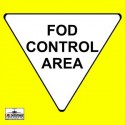From the April 2001 issue of “Flying Safety” magazine.
MSGT CHRIS D. FORNO
80 FTW
Sheppard AFB TX
Landing gear safety pins ingested by a running jet engine; a socket wrench jammed in a flight control bell crank mechanism; a stray piece of safety wire that shorts out a circuit breaker panel: All of these scenarios represent Foreign Object Damage (FOD) that could wreak havoc on combat or training missions. Even if AFI21-101, Maintenance Management of Aircraft, didn’t require it, we’d have no trouble recognizing that an effective FOD Prevention Program is vital to safe, successful flying activities in today’s Air Force. FOD costs each year typically run in the millions of dollars. In Fiscal Year 2000 alone, FOD cost the Air Force nearly $24 million, diverting valuable resources needed for the readiness of our Air Expeditionary Forces.
What is FOD? When an item that shouldn’t have been there–a foreign object–causes aircraft or support equipment damage, it’s classified as FOD. “Foreign objects” is a term that includes just about anything that “doesn’t belong,” like tools, test equipment, scraps of safety wire, extra washers, or personal items–like pocket change–that get left behind during the performance of a job. FOD can easily damage jet engines, jam critical control mechanisms or short circuit electrical components.
Doing Your Part
Supervisors of maintenance, operations and base support personnel are responsible for providing FOD awareness and prevention training to their troops who work in and around, or transit through, aircraft operational areas, as part of their daily job. But FOD prevention isn’t just a supervisory, Quality Assurance or Wing FOD Prevention Program Manager’s job–it’s an inherent responsibility for all personnel involved in Air Force aircraft and equipment operations. Some “Big Picture” perspective on preventing FOD:
- Practicing good housekeeping habits is the most effective method of eliminating FOD. “Good housekeeping” is nothing more than keeping work centers and work areas clean and orderly, ensuring extra items are picked up after task completion and accounting for all equipment and hardware at the completion of a job. Thorough, regular flight line FOD walks which include all aircraft parking areas and aircraft hangars are fundamental to preventing FOD damage.
- A tool left inside an aircraft can kill. One of Murphy’s Laws holds that a stray tool will migrate to the place where it can do the most damage–like FOD’ing an engine or jamming flight controls–resulting in the loss of a crew and aircraft.
Effective tool control programs throughout the unit are crucial. It may surprise you to learn that the Composite Tool Kit (CTK) concept hasn’t always been in existence. It wasn’t until the 1970’s that Air Force guidance was implemented to curtail the number of mishaps occurring due to lost/unaccounted for tools. When you account for tools, equipment and work order residue before departing the job site, you’ve eliminated a huge potential source of FOD mishaps.
- Control of personal equipment–hats, pens, pencils, coins, line badges and the like–is especially important since these items aren’t subject to the same organizational accountability standards as tools, tech data and other equipment.
- Using nondestructive inspection techniques–x-ray, borescope, and other state-of-the-art equipment–is strongly encouraged, particularly during major aircraft maintenance inspections. Early detection of FOD, in obscure or not-easily-accessible areas, has the potential to save people and equipment.
- Due to the environment in which operations are conducted, any number of different sources can drop, blow or otherwise deposit foreign objects in the flight line area.
Routine use of vacuums, sweeper trucks, sweeping areas by hand, vehicle tire FOD checks, and FOD walks is a must. Systematic removal of FOD means ensuring hangars, ramps, taxiways, runway, and access roads are safe for daily operations. Regular use of sweeper trucks on runways and taxiways prevents aircraft engine and tire damage. FOD collection cans in maintenance areas can prevent work residue from collecting in the wrong places. Using vacuums for cockpit cleanups and after FOD-generating maintenance–like sheet metal/machine shop type maintenance–removes debris that could lead to disaster.
- And of course, it’s always imperative to maintain heightened situational awareness around operating aircraft engines to prevent ingestion of your ear defenders, ground cord, clothing, tools and the like. Oh yeah–you, too…
Resources: FOD Prevention, Awareness and Education
Several companies offer equipment and tools that effectively counter the FOD threat. “FOD*BOSS™” is a great, new FOD prevention tool we (and several other wings) have put to use. This nifty tool, sold by the F.O.D. Control Corporation of Tucson, Arizona, is an amazingly effective and capable tool for picking up even the smallest bits of FOD from parking areas. You can get a preview of the FOD*BOSS™ capabilities at the company’s web site at http://www.fodcontrol.com.
Initial and refresher awareness training are required for most personnel, so education is the cornerstone to a successful FOD prevention program. Placing posters in work centers and on bulletin boards, and rotating them regularly can educate and motivate. The DoD’s Defense Visual Information (DVI) Directorate has several products that could be used in an education program, including training videos, awareness and education posters, CD-ROM programs and much more. You can visit the DVI Directorate’s home page on the web at http://dodimagery.afis.osd.mil/dodimagery/davis/.
The organization known as National Aerospace FOD Prevention Incorporated (NAFPI) is another great source of information. NAFPI is a non-profit educational organization dedicated to flight safety and prevention of foreign object damage. This organization has a great web site that can be found at http://www.nafpi.com/. NAFPI hosts an annual conference whose primary objective is promoting FOD prevention awareness. It attracts representatives from throughout the aerospace industry: military, space, commercial airlines, cargo haulers, airport authorities and aircraft manufacturing, repair and support. The conference provides an effective forum for the exchange of ideas and solutions and, because of the expertise of the attendees, is a key resource for information, training and support.
Only You Can Prevent FOD!
An effective FOD prevention program is one that is AGGRESSIVE. Many resources are available to implement a successful program. Today’s Air Force is ever changing and is always challenging: To be the best at what we do requires readiness. We cannot allow FOD to rob us of the valuable resources needed for the defense of our great nation!
(MSgt Chris Forno is the 80th Flying Training Wing’s Flight Safety NCO and FOD Prevention Program NCO. If you’d like to know more about the 80 FTW’s FOD Prevention Program, you may contact Sergeant Forno at: christopher.forno@sheppard.af.mil. Please note! Mention within this article of companies and their products, and organizations and their services, does not imply endorsement by the United States Air Force or Flying Safety magazine.)
Reprinted Courtesy of “Flying Safety” Magazine



